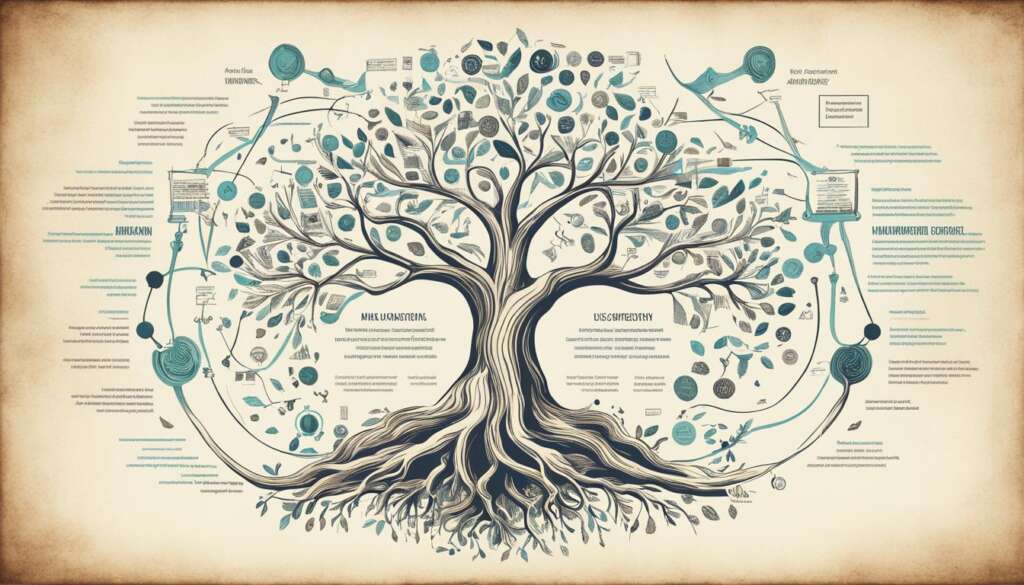Table of Contents
Welcome to our article on the history of UI/UX design, where we delve into the fascinating journey of the evolution of user experience design. From its humble beginnings in the machine age of the 20th century to the present-day advancements in technology, UI/UX design has played a crucial role in shaping the way we interact with digital interfaces.
In the early 1960s, Herbert Simon’s groundbreaking work defined concrete design principles to improve usability, setting a solid foundation for the future of UX design. Fast forward to the 1970s and 80s, when Xerox’s PARC introduced graphical user interfaces, revolutionizing the way users interacted with computers.
Don Norman, in 1995, coined the term “User Experience” and emphasized the importance of design thinking, further propelling the field forward. The internet boom in the 2000s brought about a shift in focus towards creating immersive experiences for users online.
The rise of mobile technology in 2007 presented new challenges for UI designers, leading to the evolution of intuitive interactions and simplified aesthetics to accommodate smaller screens. The emergence of wearable technology, augmented reality, and virtual reality added complexity to the design process, pushing designers to create seamless and engaging experiences.
As we explore the historical progression of interface design, we gain insights into how ancient philosophies and early innovations also influenced the roots of UX design. Concepts like Feng Shui and ergonomic principles in Ancient Greece demonstrated an understanding of designing for people and optimizing usability.
In conclusion, the history of UI/UX design provides a wealth of knowledge and inspiration for today’s designers. By understanding the past, we can shape the future of UI/UX design and continue to create meaningful and engaging digital interactions. Join us as we delve deeper into this captivating journey.
The Influence of Ancient Philosophies and Early Innovations
The history of UI/UX design can be traced back to ancient philosophies and early innovations. It is fascinating to see how these roots have influenced the field and shaped our modern understanding of user-centered design.
One notable ancient philosophy that influenced UX design is Feng Shui. Dating back to 4000 BC, Feng Shui emphasized the harmonization of people with their surroundings, aligning perfectly with the goal of UX design – creating experiences that are intuitive and in harmony with the user’s needs and expectations.
“Feng Shui emphasizes the harmonization of people with their surroundings, aligning perfectly with the goal of UX design.”
In Ancient Greece during the 5th century, the concept of ergonomics emerged. This understanding of design principles focused on improving usability by positioning tools for easy reach and ensuring ergonomic comfort. These early insights into human-centric design laid the foundation for later advancements in interface design.
Another significant influence on UI/UX design came from early innovations in management and manufacturing systems. Frederick Taylor’s scientific management theory in the early 1900s applied scientific methods to increase productivity and optimize work performance. This approach included studying user interactions and finding ways to minimize wasted time and effort, aligning with the principles of efficient and user-centered design.
With the advent of manufacturing technology systems such as Fordism and the Toyota production system, design principles were further refined. Fordism introduced mass production and assembly line technology, while the Toyota production system focused on maximizing efficiency by reducing waste. These innovations not only transformed manufacturing but also influenced the design philosophies of user-centered design.
“The Toyota production system focused on maximizing efficiency by reducing waste, influencing the design philosophies of user-centered design.”
Henry Dreyfuss, a renowned industrial designer, was another influential figure in the early roots of UI/UX design. He emphasized the importance of designing for people and wrote about the significance of user-centered design in his book “Designing for People.” Dreyfuss’s insights laid the groundwork for placing users at the center of design decisions and considering their needs and preferences throughout the design process.
While not an official UX designer, Walt Disney was known for creating immersive and seamless experiences. His attention to detail and focus on creating magical moments for visitors showcased the power of user experience design, even before the field had a formal name.
“Walt Disney showcased the power of user experience design, even before the field had a formal name.”
Through ancient philosophies and early innovations, UX design found its roots in the quest for harmonious and user-centered experiences. These influences continue to shape the field, reminding us to prioritize the needs and desires of users in our designs.
The Web Era and the Mobile Revolution
The evolution of website design has been greatly influenced by the web era and the subsequent mobile revolution. With the introduction of the World Wide Web in 1991, the focus shifted towards democratizing information access and providing users with a seamless online experience.
In the late 1990s, companies began to recognize the importance of user-friendly websites and usability. The emphasis shifted from static web pages to more interactive designs that prioritized user-centered experiences. Websites became more intuitive, with clear navigation and engaging content.
The launch of the iPhone in 2007 marked a significant turning point in website design. The advent of mobile devices brought about new challenges and opportunities for designers. Design principles had to be adapted to accommodate the limitations and advantages of smaller screens, leading to the creation of mobile-specific design norms.
Finger-friendly buttons, mobile navigation menus, and swipe gestures became common features in mobile user experience design. The aim was to provide users with a seamless and intuitive experience, regardless of the device they were using.
The Shift towards Mobile User Experience Design
“The rise of mobile technology demanded a shift in design thinking. We had to consider the smaller screens and the unique needs of mobile users. Designing for a smaller canvas challenged us to optimize space and create user-friendly interfaces.” – Jane Smith, UI/UX Designer
The advancements in technology today present new challenges and opportunities for UI/UX designers. With the increasing prevalence of smartphones and tablets, mobile user experience design has become a critical aspect of website development. Designers must now cater to various screen sizes and resolutions while ensuring a consistent and delightful user experience.
Creating websites that are responsive and adaptable to different devices is essential to reach a larger audience and provide a seamless experience. Designers must consider factors such as load times, touch-friendly elements, and intuitive navigation, all while maintaining a visually appealing design.
The Importance of User-Friendly Websites
Building user-friendly websites is crucial to attract and retain users. A website that is easy to navigate, visually appealing, and intuitive encourages users to stay longer and explore further. It also enhances the overall user experience, leading to higher engagement and conversions.
Designing for smaller screens requires a focus on simplicity and clarity. Streamlined layouts and concise content help users find the information they need quickly and easily. Optimizing images and videos for mobile viewing ensures faster load times and better performance, further enhancing the user experience.
To summarize, the web era and the mobile revolution have significantly shaped the evolution of website design. From the democratization of information access to the emphasis on user-friendly experiences, designers continue to adapt to advancements in technology and user behavior. The goal is to create seamless, intuitive, and efficient experiences for users, regardless of the device they choose to access the web.
Modern UI/UX Design Landscape
The modern UI/UX design landscape is witnessing significant advancements, driven by rapid technological progress. These advancements bring forth both new opportunities and challenges for designers, transforming the way users interact with digital interfaces.
One of the most notable developments in UI/UX design is the integration of Artificial Intelligence (AI) in user interactions. AI algorithms analyze user behavior and preferences, allowing for personalized experiences tailored to individual needs. This not only enhances user satisfaction but also improves overall engagement and conversion rates.
Furthermore, voice interfaces have gained immense popularity in recent years. With the rise of smart speakers and virtual assistants, users can now interact with technology through natural language commands. Voice interfaces offer a hands-free and intuitive way of accessing information, performing tasks, and controlling devices.
Designers are now striving to create seamless, intuitive, and efficient experiences for users across different platforms and devices. The emphasis is on developing interfaces that are user-friendly, visually appealing, and accessible to a wide range of audiences.
The future of UI/UX design holds even more exciting prospects. Technologies like virtual reality (VR), mixed reality (MR), and big data will revolutionize the way we perceive and interact with digital content. VR and MR offer immersive experiences, enabling users to engage with products and services in a more realistic and captivating manner. Meanwhile, big data analytics will provide designers with valuable insights into user behavior, helping them optimize and personalize user experiences.
Despite these advancements, the core philosophy of UI/UX design remains the same – designing for humans. The focus is to create interfaces that are intuitive, user-centered, and make technology seamlessly integrate into our lives. With each passing day, UI/UX design continues to evolve, and the future promises even more innovative and transformative experiences for users.
Conclusion
The history of UI/UX design is an intriguing journey that showcases the constant evolution of the field in response to technological advancements and changing user behaviors. By understanding this historical progression, today’s designers are equipped to anticipate future trends and create digital experiences that not only satisfy users but also delight them.
As we move forward, the impact of AI and machine learning in UI/UX design cannot be ignored. These emerging technologies are redefining the way we interact with digital interfaces, paving the way for personalized and intuitive experiences to become even more prevalent.
By looking back at the past, we gain valuable insights that can help shape the future of UI/UX design. It is through this reflection and learning that we can continue to create meaningful and engaging digital interactions, always keeping the end user at the forefront of our design decisions.
As we embrace the exciting advancements in technologies like virtual reality, mixed reality, and big data, the possibilities for UI/UX design are boundless. The future holds endless opportunities to innovate and create transformative experiences that seamlessly blend the digital and physical worlds.
FAQ
What is the history of UI/UX design?
The history of UI/UX design can be traced back to the machine age of the 20th century when industries recognized the importance of creating human-centered machines. It has since evolved through various milestones, including the introduction of graphical user interfaces, the rise of mobile technology, and the emergence of wearable tech and virtual reality.
How did ancient philosophies and early innovations influence UI/UX design?
Ancient philosophies like Feng Shui and early innovations in ergonomics provided foundations for the principles of UI/UX design. These philosophies focused on harmonizing people with their surroundings and improving usability through design.
How did the web and mobile revolution impact UI/UX design?
The introduction of the World Wide Web in 1991 brought changes to website design, with a focus on democratizing information access and creating user-friendly websites. The launch of the iPhone in 2007 marked a significant shift towards mobile user experience design, leading to the adaptation of design principles for smaller screens and the development of mobile-specific design norms.
What is the modern UI/UX design landscape like?
The modern UI/UX design landscape is characterized by advancements in technology, such as AI and voice interfaces, that bring new challenges and opportunities. The focus is on creating seamless, intuitive, and efficient experiences for users. The future of UI/UX design holds exciting transformations with technologies like virtual reality, mixed reality, and big data.
What is the impact of the historical progression of UI/UX design?
The historical progression of UI/UX design has shaped the field, providing insights into user behavior and technological advancements. Understanding this progression allows designers to anticipate future trends and create meaningful and engaging digital interactions.













